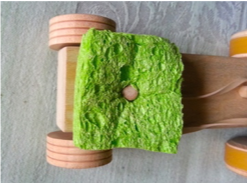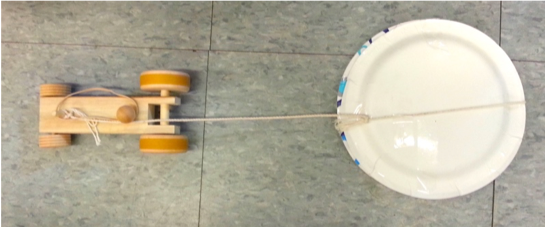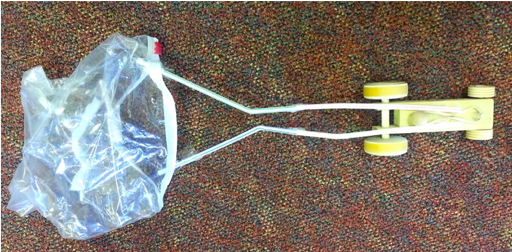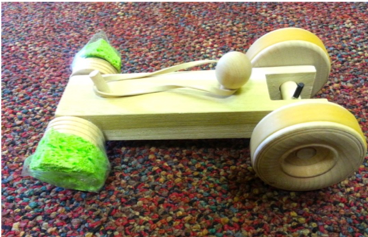Background Information
1. Notes About Engineering
In this Investigation, students do what engineers are asked to do: solve a problem. The iterative process that students utilize to solve the problem includes generating an idea for how to solve the problem, implementing and testing the idea, collecting data, applying critical thinking as they evaluate the results, refining the design, and stepping through the process again until they have solved the problem. These and other practices are fundamental to design.
A key to successful design is to approach the process outlined above in a systematic way, but in their enthusiasm and sometimes impatience to address the challenge, students can miss the "systematic" part and possibly lose track of where they have been or where they need to go next. One purpose of the Student Notebook, in which students document their steps and their results throughout the challenge, is to help them be more systematic, hopefully reducing or preventing the inefficiency or chaos that can result from an undisciplined "trial and error" process.
2. Design Types
The examples below show some of the popular approaches students used to reduce the travel of the car during early classroom trials. You will undoubtedly see additional approaches. These examples are for your information only. The demonstration at the start of class along with the general design guidelines and materials will be more than adequate to get students started.
A. Increased Wheel Friction Attaching something to the body of the car that rubs against the wheels as they turn is a popular approach. It is the approach used in the demonstration at the start of class: pressing the shaft of the digital thermometer against a wheel to bring it to a stop sooner than it would otherwise have stopped.

B. Increased Floor Friction Using string to have the car drag a sponge or paper plates carrying various amounts of weight was another popular approach.

C. Air Resistance The friction between a moving object and the surrounding air (or water) is commonly referred to as drag, and is another approach to transforming motion energy into thermal energy via friction. (Students made a special request to use the bag that the materials came in, and were granted permission.)

"Wasted Motion" This is NOT a design that relies mainly on using friction and so should not be an acceptable solution. It is included here only to give you an example of what some students may propose, and to help you explain why it does NOT meet the design constraints of today's challenge. In this case, some of the elastic energy causes the car to have an up-down motion in addition to forward motion, so the result was less forward motion.

3. Science Standards
Next Generation Science Standard Performance Expectation 4-PS3-4 reads, Apply scientific ideas to design, test, and refine a device that converts energy from one form to another. In this challenge, the device that students design, test, and refine is the mechanism they add to the car that brings the car to a stop within the target zone. The scientific idea that students apply is that motion energy can be converted to thermal energy via friction.
4. Energy Transformation and Imperceptible Change
In this design challenge, the approach students use—transforming motion energy to thermal energy via friction—is exactly the same approach engineers use to help us control our cars, trucks, trains, bicycles, and more. It is the same approach a child uses to bring a scooter to a stop by dragging a shoe along the ground. In all of these examples, motion energy is transformed into thermal energy via friction, and that thermal energy—of the brakes, or the child's shoe—is eventually transferred to the air.
Yes, the braking mechanism students design for the wooden cars will gain thermal energy (become slightly warmer than room temperature) once the car is in motion, but it will be a very tiny gain, with an imperceptible increase in temperature. And that tiny increase in thermal energy will eventually transfer to the atmosphere, because thermal energy always flows from a warmer (brakes) to a cooler (room temperature air) object. The concept of imperceptible change is a challenging one for students, but accepting the idea that change can happen even when one can’t perceive it is key to understanding the flow of energy in the case of the wooden car, or to understanding why the car ever stops once it is moving, or to understanding thousands of other situations we encounter in the world around us.
True, students have probably accepted the idea that whenever there is an energy loss in one place there must be a gain in another place. This is obvious when one ball collides with another. But when an obvious loss (motion energy) is paired with an imperceptible gain (thermal energy), the concept of balanced gains and losses is not so clear. Hopefully, the combination of students’ prior experiences in the curriculum, the demonstration with the wheel and the thermometer at the start of class, the hands-on work in this engineering design challenge, and the debriefing, will help students strengthen their understanding of this important gain-loss energy concept.
5. The "Friction" Word
Although the term friction has been used several times in the notes above it is not introduced to students in the curriculum unit. Defining friction leads to a whole new set of ideas in an investigation that already has some challenging ideas. If students suggest the word and are using it appropriately, agree that friction is involved, but leave it at that. The key goals of the investigation can be met simply by focusing on the concept that when objects rub together the result is that motion energy is transformed into thermal energy. Those are terms with which students are already familiar.